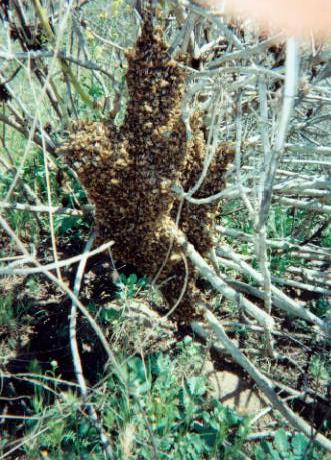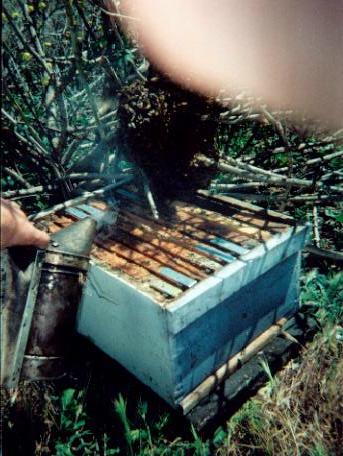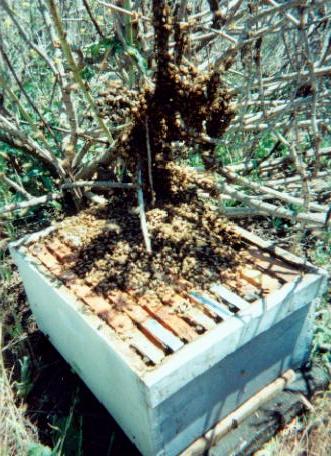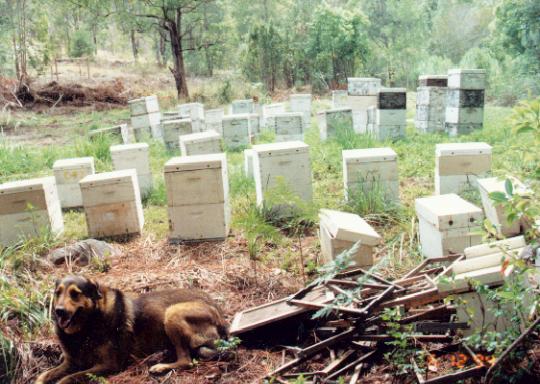STARTING YOUR FIRST HIVE
The first thing you are going to need to do
is get your equipment then your bees.
Some people have caught a swarm then got there equipment
but it is not good to have bees sitting in a cardboard box
for a long time while you collect your gear
Here is a
bee hive that can be built from materials available at
your local hardware store often from scraps. bee hive
what you will need is
A box any of the standard size available will do(
9 5/8 inch) but you
might want to consider that if you don't like to handle heavy weights
it may be an idea to go for one of the lighter sizes
frames,foundation,wire if applicable,a veil gloves,hive tool
smoker,some form of extractor this is probably borrowable
Your local agricultural supply store may be able to supply your needs
or you can buy what you need online at www.dadant.com
Dadant has a good beginner or hobby kit which has all the beginner needs
excepting bees for these contact a local beekeeper or package bee supplier
queens,packages and nuc colonies are generally available april to june
You are also going to need some basic tools such as hammer nails,paintbrush
paint.
Spring is probably the best time to start a new hive
there is lots of pollen around,this allows the hive to
build up strong.the hive needs a plentiful supply of pollen
to make baby bees as well as a good nectar source
CATCHING A SWARM
Alright I am getting a little lost here you have got all your
equipment lets assume your first hive is going to be a swarm.
old farmer Jones calls you up and tells you
that there is a swarm hanging from a bush near
his milking shed

Its really just a matter of dropping the swarm into
the box.get your veil smoker and box. a small shake
of the branch that the hive is on with the box underneath

A bit of smoke and you have many thousands of bees
marching into there new home.

Sometimes it really is
that easy my very first hive was a swarm
caught just like that.word of warning watch out for African
bees in the U.S.A.I don't go out of my way to catch swarms
anymore to many times they have been 5 to 10 meters
up a tree and that really complicates things.
and more common than that the "swarm" is actually
a fully established hive already set up in a
hollow tree or worse a house.
I like to leave the hive in that position
for a couple of days just to let it settle down.
Most of the time you will come back to a good
working hive.Sometimes though the hive will
bug out again or they have lost there queen
and there is not a lot you can do about it.
If you don,t want to wait to catch a swarm or
don,t want to take your chances with African bees
your alternative is to contact a beekeeper
and either purchase an established hive
or a nucleus hive and get going from there
this is actually what I would recommend for first
time beekeepers.a nucleus hive (or package)will be cheap but
you may not make any honey the year that you buy
it.
MOVING A HIVE
To move a hive you could just turn up at lunchtime
pick up the box and off you go but you are going
to lose a lot of field bees that is bad and your
old mate farmer Jones is probably going to be calling
you about a swarm you left behind he might even be
purturbed about the matter that is very bad.
So you have got to get to moving your hive when
all the bees are in the hive that means get up very
early or leave it until just before dark.
if there are still bees flying in and out
of the hive it is not a good time to move it.
there is two basic ways to move a hive one is
enclosed moving where all entrances are closed
and the other is open when the entrances are left
open.
Closed entrances take more time and if it
is a long trip the hive may overheat but the hive
is kept inside the box which can be a big advantage
if you are not going to get to the final destination
until the warmer part of the morning.
Open entrance moving is quicker and the bees keep
cooler but you had better get to where you are
going before the day warms up
One more note about moving always cover your bees
with a net to prevent anybody getting stung by your bees
and remember to lift with your legs not your back
and get a mate to help you, hives can get very heavy.
Ok thats it for starting,acquiring and moving the
hive very short and I know I left a lot out but thats the basics.

Installing a package of bees
The next part in beekeeping will be care
and maintainance of your hive.
Installing a package of bees
other very helpful links



